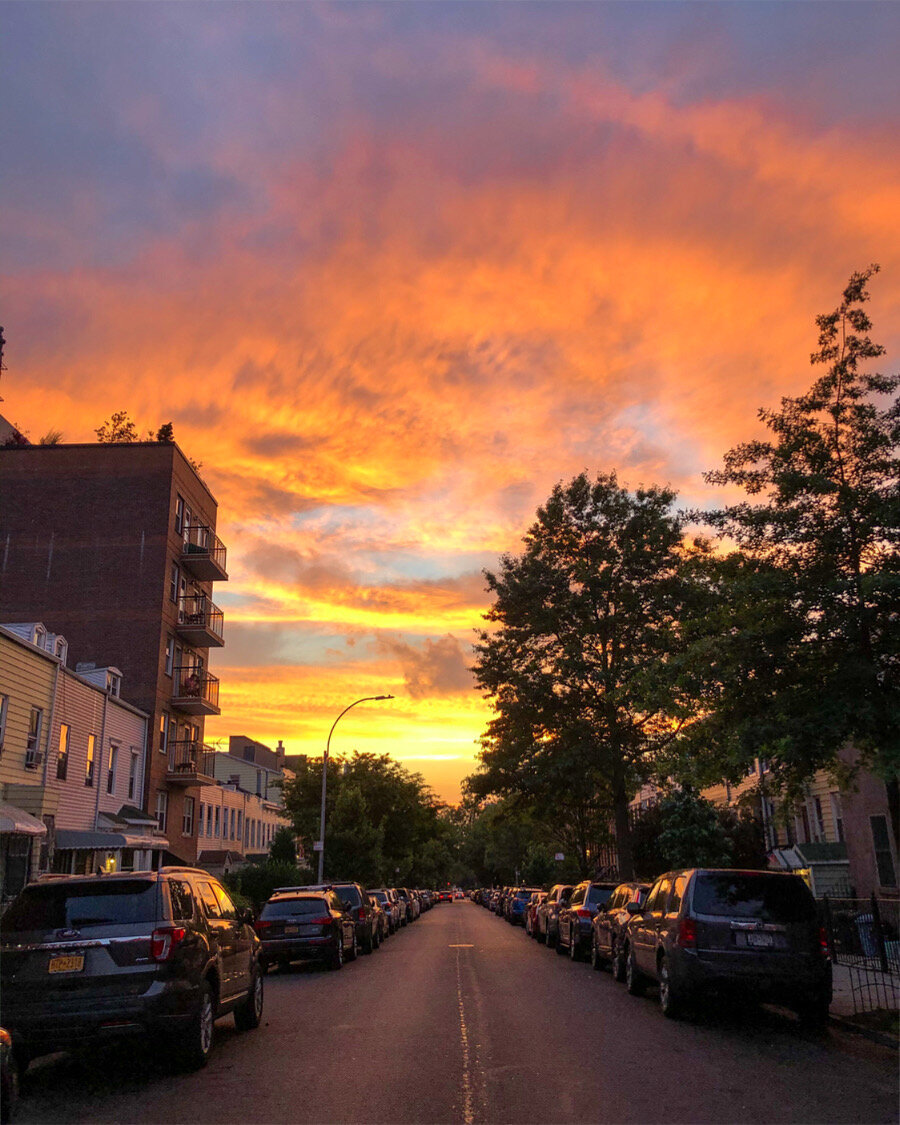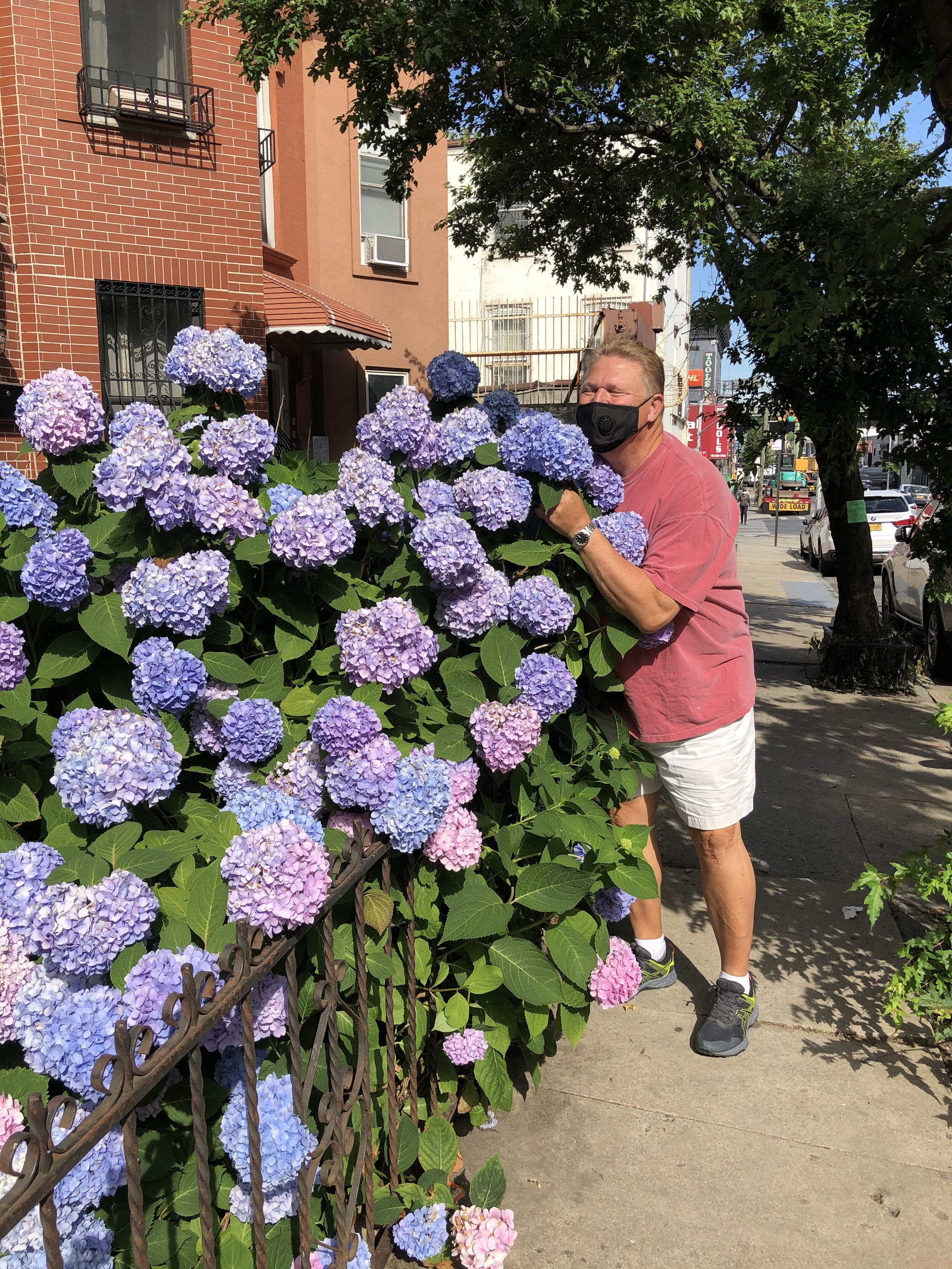As I walk around Brooklyn, the air is cool.
People have on cozy sweaters and hold cups of warm coffee as they talk to neighbors. The leaves crunch beneath my feet. Someone is selling roasted nuts, and the mouth-watering smell encompasses the block. There’s a family picnicking in Prospect Park, warm bagels in hand.
The only striking difference between this season and any other autumn in New York is that we’re in a pandemic.
So we wear masks over our mouths and noses. Even the kids at the playground on 5th Avenue sport “Black Panther” and “Frozen” fabric face coverings. Indoor dining is not permitted yet—so bars have moved their TVs outside and put up tents with heat lamps. There’s chatter in the streets and the occasional sound of a football whistle.
The fall-themed stoops of Park Slope, Brooklyn.
This is an incredible improvement from April, when we lost over 700 of our neighbors every day for a week. If you weren’t here, with the body bags and the overrun morgues and the messages on shop windows begging for prayers, then I’m not sure I’ll ever be able to quite explain the darkness that settled over our city. You’ll have to trust me when I say there was tangible sadness in the air.
Signs from Brooklyn in April 2020
This strange year has brought waves of transition. Spring bloomed with death and confusion. First, we watched as wealthy New Yorkers fled to their second homes. We saw students pack up and leave, many with no immediate plans to return. Others went back to their hometowns to wait out whatever was to come. The virus continued to spread, and some of these transplants unwittingly dragged the sickness with them. Other states began to brace for the unknown.
Then, the city grew eerily quiet. The daily TV briefings and text messages began. Times Square sat deserted, void of actors, commuters, and tourists. The Villages no longer buzzed with nightlife. By week three of self-isolation, as the death toll continued to climb, we knew this was not going to be a quick quarantine. One Friday night in early April, I drank a martini, put in my headphones, and cried—perhaps for too long—about the lost plans of 2020.
At Day 56 of self-isolation, I called my mom and asked if we could visit my home state of Virginia for a few days (with precautions). Because my husband and I were both working from home, I’d spent hours hunched over my computer in our bed while he spent hours at our not-so-comfortable kitchen table. There was only a folding closet door between us as we both talked through endless Zoom meetings. I’d woken up, worked, and slept in the exact same place for months. So visiting Virginia was like going on an all-expenses paid vacation to Europe. Those few days away helped shift me into a healthier head space.
A quiet trip to Colonial Beach, Virginia.
Summer sizzled with relaxation and rage. Amidst all the COVID deaths, we then witnessed extreme police violence both on TV and in our neighborhoods. We grappled with Black injustice. People filled the streets across the nation and curfews were imposed. Statues crumbled. There was backlash, confusion, and many heavy conversations. More people died. My grandmother passed away. I attended virtual weddings, funerals, baby showers, and bachelorettes. Dad helped us move apartments. I worked 14-hour days and then took my first vacation since Christmas. We marched to City Hall, we signed petitions, we clapped for healthcare workers, and throughout it all we hoped that the infection rate of the coronavirus would slow.
My community has been affected by the pandemic. We lost bartenders, co-workers, and parents of people we know. Luckily, while my immediate friend group has seen sickness, we have not experienced death. Some of my friends haven’t left the city since March; some have been gone for months. Some will never come back.
I’m still here, in part because my husband has returned to physically working in an office. Ryan’s commute has kept a few people at arm’s length, even though he gets tested weekly. I have to remind myself that individuals handle their anxieties in different ways—and being cautious is wise. But there is isolation in the way we live this season. I am distant with people I once took for granted.
I’m also still here because this is home. New York is in my blood, and her addiction is strong. There are no dark jazzy bars, no endless night out, no theater—but even without being my Neverland, I can’t see myself anywhere else. That could change; it just hasn’t yet. It’s not my time. Ten years has not been enough.
Many aspects of life look very different, like school, work, and the commute. People don’t have jobs and parents are strained in tiny apartments that were never intended to harbor its occupants for so long.
But then some things will always be the same. My friends are having babies. People are falling in and out of love. Families are strolling through parks and museums again. The man on the street corner is still selling warm, roasted nuts.
And when you walk around the streets of Brooklyn in fall, the leaves will crunch beneath your feet. You might hear the shouts of a protest at Grand Army Plaza, or the cheers of people watching a football game at a bar on 5th. You’ll see kids on scooters and pumpkins on row house stoops.
You might even spot me, wandering the city blocks I so adore, thinking both about what comes next—and how to make the most of this surreal moment in history.
My backyard in Greenwood Heights.
“Don’t you love New York in the fall? It makes me want to buy school supplies. I would send you a bouquet of newly sharpened pencils if I knew your name and address.”







